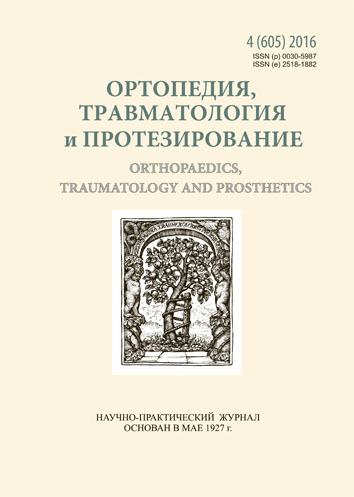Morphological features osteointegration of porous tantalum implants in rats
DOI:
https://doi.org/10.15674/0030-5987201645-10Keywords:
porous tantalum, bone regeneration, osteoporosisAbstract
Among the metallic materials, porous tantalum attracts growing attention of orthopedics and traumatologists. The purpose of the study is to investigate osseointegration by using a porous tantalum implants in rats with normal bone health and osteoporosis simulated background.
Methods:the study was performed in 18 laboratory rats weighing 250–350 g. Osteoporosis modeled in 9 animals with the help of ovariectomy in 3 months prior to implantation. 3 mm diameter defect produced in the distal femoral metaphysis in normal rats (control) and with osteoporosis (experimental), porous tantalum pins implanted. After 14, 30 and 90 days postoperatively the material was examined by using a histology techniques.
Results:it was found that the orientation of osteoreparation process was identical for both groups of animals, ie at all stages of monitoring, the formation of bone around the implant. However, in comparison with the control group osteoporosis animals had larger areas of direct contact with the tantalum implant intertrabecular spaces of the bone marrow and the formation of the parent bone connective tissue sections. In control and experimental animals 90 days postoperatively bone tissue formed around the implant was presented collagen type I with a different refraction of collagen fibers. It is proved a good biological compatibility of porous tantalum implants with bone tissue and bone marrow, as well as higher quality of osseointegration. In animals with a normal structure of the bone implant 73.1 % of the perimeter was surrounded by mature bone tissue. In rats with osteoporosis this value was also quite high and amounted to 57.7 %.
Conclusions:the study has evidence indicating that tantalum implants can be used in orthopedics and traumatology in patients with normal bone health and osteoporosis.References
- Korzh NA, Malyshkina SV, Dedukh NV, Timchenko IB. Biomaterials in Orthopedics and Traumatology — the role of AA Korzh development problems. Heritage. Alexey Korzh: scientific and historical edition; edited by LD Goridova. Kharkiv, 2014. рр. 35-49. (in Russian)
- Dedukh NV, Pobel EA. The bone tissue at norm and in osteoporosis: preparations of calcium and vitamin d (a review of literature). Orthopedics, Traumatology and Prosthetics. 2013;(3):92-8. doi: 10.15674/0030-59872013392-98. (in Russian)
- European convention for the protection of vertebrate animals used for experimental and other scientific purposes. Council of Europe. Strasbourg, 18 Mar 1986.
- The Law of Ukraine №3447-IV from 21.02.2006 «On protection of animals from cruelty» (Article 26).
- Muzichenko PF. Materials Issues in Orthopedics and Traumatology. Lіkaryu shcho praktykue. 2012;13(1):94-8. (in Russian)
- Popkov AV. Biocompatible implants in traumatology and orthopaedics (A review of literature) (review). Orthopaedic Genius (Genij Ortopedii). 2014;3:94-99. (in Russian)
- Sarkisov DS, Perov JL. Microscopic techniques. Moskow: Medicine, 1996. 542 p. (in Russian)
- Povoroznyuk VV, Dedukh NV, Grigorieva NV, Gopkalova IV. Experimental osteoporosis. Kyiv, 2012. 228 p. (in Russian)
- Wauthle R, van der Stok J, Amin Yavari S, Van Humbeeck J, Kruth JP, Zadpoor AA, Weinans H, Mulier M, Schrooten J. Additively manufactured porous tantalum implants. Acta Biomater. 2015;14:217–25. doi: 10.1016/j.actbio.2014.12.003.
- Schildhauer TA, Robie B, Muhr G, Koеller M. Bacterial adherence to tantalum versus commonly used orthopedic metallic implant materials. J Orthop Trauma. 2006;20(7):476–84.
- Balla VK, Bodhak S, Bose S, Bandyopadhyay A. Direct laser processing of tantalum coating on titanium for bone replacement structures. Acta Biomater. 2010;6 (6):2329–34. DOI: 10.1016/j.actbio.2009.11.021.
- Junqueira LC, Bignolas G, Brentani RR. Picrosirius staining plus polarizationmicroscopy, a specific method for collagen detection in tissue sections. Histochem J. 1979;11(4):447–55.
- Paganias CG, Tsakotos GA, Koutsostathis SD, Macheras GA. Osseous integration in porous tantalum implants. Indian J Orthop. 2012;46(5):505–13. doi: 10.4103/0019-5413.101032.
- Matassi F, Botti A, Sirleo L, et al. Porous metal for orthopedics implants. Clin. Cases Miner. Bone Metab. 2013;10(2):111–115.
- Balla VK, Bose S, Davies NM, Bandyopadhyay A. Tantalum – а вioactive мetal for implants. JOM. 2010;62(7):61–4. doi: 10.1007/s11837-010-0110-y.
- Wang Q, Qiao Y, Cheng M, Jiang G, He G, Chen Y, Zhang X, Liu X Tantalum implanted entangled porous titanium promotes surface osseointegration and bone ingrowth. Sci Rep 2016;6:26248. doi: 10.1038/srep26248.
Downloads
How to Cite
Issue
Section
License
Copyright (c) 2016 Ninel Dedukh, Stanislav Bondarenko, Volodymyr Filipenko, Inna Batura

This work is licensed under a Creative Commons Attribution 4.0 International License.
The authors retain the right of authorship of their manuscript and pass the journal the right of the first publication of this article, which automatically become available from the date of publication under the terms of Creative Commons Attribution License, which allows others to freely distribute the published manuscript with mandatory linking to authors of the original research and the first publication of this one in this journal.
Authors have the right to enter into a separate supplemental agreement on the additional non-exclusive distribution of manuscript in the form in which it was published by the journal (i.e. to put work in electronic storage of an institution or publish as a part of the book) while maintaining the reference to the first publication of the manuscript in this journal.
The editorial policy of the journal allows authors and encourages manuscript accommodation online (i.e. in storage of an institution or on the personal websites) as before submission of the manuscript to the editorial office, and during its editorial processing because it contributes to productive scientific discussion and positively affects the efficiency and dynamics of the published manuscript citation (see The Effect of Open Access).














